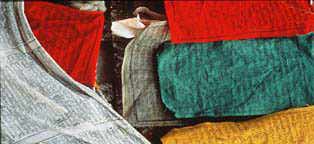Tibetans have never had it easy. Theirs is a harsh environment and human habitation has always been a precarious proposition. Even so, the deliberate cultural strangling inflicted by the Chinese occupiers since 1950 rates as the worst misfortune the inhabitants of the 'Land of Snows' have been forced to endure.
Tibetan Buddhism, which developed out of Indian Tantric Buddhism and the indigenous animistic Bon religion, spread through Tibet by the 7th century. Political differences led to the formation of the Yellow and Red Hat sects, with the Yellow Hats prevailing under the leadership of a succession of Dalai Lama god-kings. Each Dalai Lama is considered the reincarnation of the last, upon whose death the monks search for a newborn child who shows some sign of embodying his predecessor's spirit.
With the fall of the Qing Dynasty in 1911, Tibet entered a period of independence which lasted until 1950 when the People's Liberation Army entered the region. Tibet was no liberal democracy (it was a highly repressive theocracy based on serfdom) and the Chinese truly believed their occupation was a mission of mercy. Indeed, until a massive rebellion in 1959, Tibet's political, social and religious organisations were left intact.
Post-1959 Communist Tibet, however, was subjected to the disaster that was the Cultural Revolution. About 1.2 million deaths were attributable to the 'liberation', 100,000 people (including the Dalai Lama) fled their homeland, the number of monasteries was reduced from about 1600 to a lonely 10 (monks were executed or sent to work in fields and labour camps), and land reforms made a mess of the economy. The Dalai Lama continues to be worshipped by his people, and his acceptance in 1989 of the Nobel Peace Prize marked a greater sympathy on the part of the Western world for the plight of the Tibetan people. Unfortunately, China's market potential makes most world leaders wary of pressing the issue of Tibetan independence.
Lhasa, the heart and soul of Tibet and an object of devout pilgrimage, is still a city of wonders. The Potala, a vast white and ochre fortress, dominates the Lhasa skyline. Once the seat of Tibetan government and the location of the tombs of previous Dalai Lamas, the Potala serves as a symbolic focus for Tibetan aspirations. Today though, it is the Jokhang temple, 2km to the east, which is the spiritual heart of the city. The medieval push and shove of crowds, the street performers, the stalls hawking everything from prayer flags to jewel-encrusted yak skulls, and the devout tapping their foreheads to the ground at every step is an exotic brew that few newcomers can resist. Among Tibet's other attractions are Shigatse, around 250km south-west of Lhasa and the seat of the Panchen Lama (the reincarnation of whom the Dalai Lama and the Chinese government are currently disputing), and Mt Kailash, a beautiful range of peaks.
Flights to Gonggar airport, 90km from Lhasa, depart Beijing via Chengdu (Sichuan); Chongqing (Sichuan); and Kathmandu. There are five major road routes to Lhasa but foreigners are only supposed to use the Nepal (Friendship Highway) and Qinghai (via Golmud) routes. Most travellers band together to rent a 4WD for the spectacular journey to Nepal. Getting around Tibet can be difficult: the buses are often at their last gasp and travelling by 4WD can be expensive. Trucks tend to charge the same inflated prices as buses, but the Chinese government discourages foreigners from hitching rides. 'Road safety' is little more than a slogan. Tibetans tend to rely on prayer to facilitate a safe arrival - you might consider doing the same once you see the conditions. Bicycling is possible, but is not without its hazards: cyclists in Tibet have died from road accidents, hypothermia and pulmonary oedema. You can fly to Xining from Beijing, Chengdu, Guangzhou (Guangdong) and Ürümqi (Xinjiang). There are frequent rail connections to Lanzhou (Gansu) and more erratic services to Beijing, Shanghai and other regional centres.



 Attractions
Attractions
 Off the Beaten Track
Off the Beaten Track Getting There & Getting Around
Getting There & Getting Around Lonely Planet Guides
Lonely Planet Guides Travellers' Reports
Travellers' Reports On-line Info
On-line Info